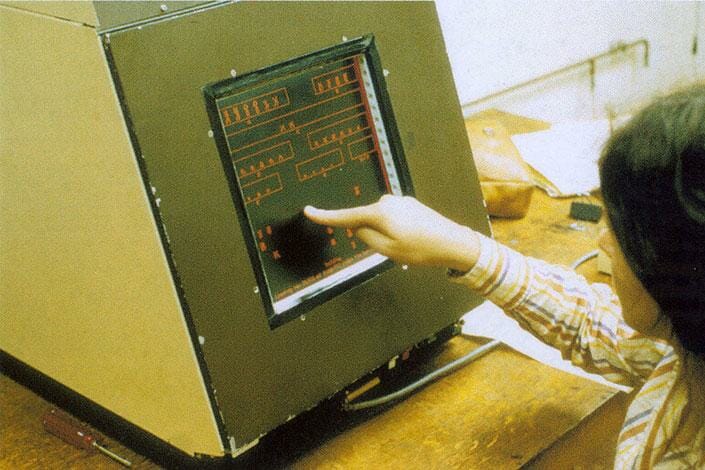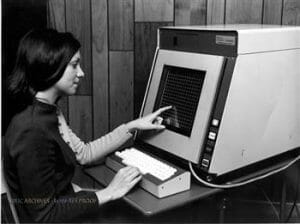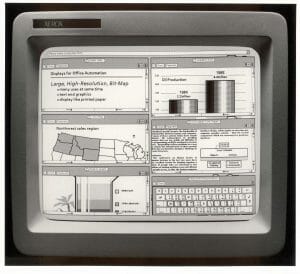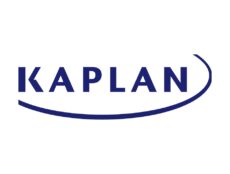
When most people think about eLearning, they think about developments over the past two decades. While it is true that eLearning has grown rapidly since the late 1990s and continues to represent at growth market, eLearning’s origins actually stretch back to the early days of computing. One major contribution to the early years of eLearning was PLATO–an acronym for Programmed Logic for Automatic Teaching Operations. PLATO not only changed eLearning, however, it also changed the world and how we communicate with each other on innumerable levels.
 Despite PLATO’s major influence, however, Don Bitzer, one of the system’s two original developers, reflects upon the project in remarkably modest terms: “We were concerned about what was happening in our primary and secondary schools—large, intercity schools where close to 50% of the students were coming out functionally illiterate.” Bitzer also recognized that in order for any “teaching machine” to work, it would need to be both affordable and easy to use: “We realized that we would have to create hardware that could deliver a large variety of courseware that the students would be comfortable with. We also realized that the software would have to support the students’ learning needs and the teachers’ needs (the ability for a teacher to easily write new courseware and develop new teaching strategies) without them being computer experts.”
Despite PLATO’s major influence, however, Don Bitzer, one of the system’s two original developers, reflects upon the project in remarkably modest terms: “We were concerned about what was happening in our primary and secondary schools—large, intercity schools where close to 50% of the students were coming out functionally illiterate.” Bitzer also recognized that in order for any “teaching machine” to work, it would need to be both affordable and easy to use: “We realized that we would have to create hardware that could deliver a large variety of courseware that the students would be comfortable with. We also realized that the software would have to support the students’ learning needs and the teachers’ needs (the ability for a teacher to easily write new courseware and develop new teaching strategies) without them being computer experts.”
PLATO’s Origins
eLearning is said to begin at the University of Illinois at Urbana-Champaign back in 1959. This is when Daniel Alpert and Don Bitzer launched PLATO. While learners could access 15,000 hours of curricular materials from a centralized hub, they still had to visit the campus computer lab to do so.
PLATO’s First Decade
- 1959-1960: Early development
- 1961: First teaching experiment with PLATO in higher education
- 1965: First complete college course delivered using PLATO
- 1969: First remote location set up at Springfield High School in Springfield, Illinois
In many respects, PLATO’s initial goals were relatively modest. In The Computer in the School, a 1975 book by Justin C. Baker, PLATO’s goals are described as followed: “By far the most extensive computer-based system in this country, the PLATO goal is to connect 4,096 student terminals by means of telephone lines to the large central  Control Data Corporation 6000 series computer system. In March of 1974, there were 450 terminals in the PLATO network.” Not surprisingly, at the time, cost was a major consideration. As Baker reports, “A major objective of the University of Illinois project is to make computer-based education economically possible. Around 1972 an estimated cost, based on optimum use of the PLATO system with the inclusion of computer costs, communication lines, terminal equipment and the development of instructional materials, was between 50 cents and 75 cents per student per terminal hour. By the time the full 4,096 terminal network is operable, Dr. Bitzer hopes to have costs reduced below 50 cents. A cost of 10 cents per student per terminal hour in the near future is not unrealistic.”
Control Data Corporation 6000 series computer system. In March of 1974, there were 450 terminals in the PLATO network.” Not surprisingly, at the time, cost was a major consideration. As Baker reports, “A major objective of the University of Illinois project is to make computer-based education economically possible. Around 1972 an estimated cost, based on optimum use of the PLATO system with the inclusion of computer costs, communication lines, terminal equipment and the development of instructional materials, was between 50 cents and 75 cents per student per terminal hour. By the time the full 4,096 terminal network is operable, Dr. Bitzer hopes to have costs reduced below 50 cents. A cost of 10 cents per student per terminal hour in the near future is not unrealistic.”
In the end, PLATO’s modest goals were soon exceeded. By the early 1980s, the system offered approximately 7,000 hours of instructional material on 150 subjects and the system’s programs were reaching 7000 terminals in countries around the world from Australia to Canada to Belgium.
PLATO’s Legacy
 From its evidently modest beginnings, PLATO continued to grow. Over time, PLATO grew into an online learning program designed to link users in locations well beyond the Loomis Laboratory on campus. Beyond driving developments in eLearning, however, PLATO also had two other major impacts.
From its evidently modest beginnings, PLATO continued to grow. Over time, PLATO grew into an online learning program designed to link users in locations well beyond the Loomis Laboratory on campus. Beyond driving developments in eLearning, however, PLATO also had two other major impacts.
First, PLATO is frequently credited with driving the development of bulletin boards and chats. Second, PLATO’s technology directly informed the technologies that led to the Xerox Star, which was the first computer to feature a graphical user interface. Of course, as legend has it, the Xerox Star later lent inspiration to Steve Jobs who would bring the Xerox Star’s technologies to Apple Inc. and well, the rest is history.
Although the experiment was abandoned just as eLearning started to gain widespread acceptance both in the education and training sectors in the early 1990s, PLATO’s influence remains ubiquitous. Indeed, as a result of a series of strategic acquisitions, several current eLearning providers, including Pearson Digital Learning, are direct descendants of PLATO. One may easily argue, however, that without PLATO, the robust learning management systems now on the market would not have taken shape.









One Comment